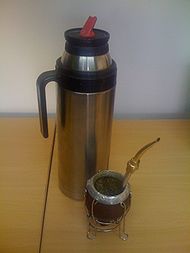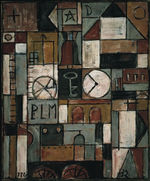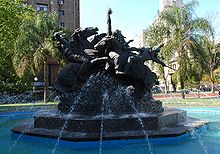- Culture of Uruguay
-
Topics Communications
Culture
Demographics
Economy
Education
Foreign relations
Geography
Government
History
Military
Politics
Religion
Tourism
Transport
Uruguay Contemporary Uruguayan culture is diverse in its nature since the nation's population is one of multicultural origins. The country has an impressive legacy of artistic and literary traditions, especially for its small size. The contribution of its alternating conquerors, Spain and Portugal, and diverse immigrants -Italians, Germans, Swiss, Russians, Jews and Armenians, among others- has resulted in traditions that integrate this diversity with Native American elements. Uruguay has centuries-old remains and fortresses of the colonial era. Its cities have a rich architectural heritage and an impressive number of writers, artists, and musicians. Carnival and candombe are the most important examples of African influence by slaves, as well as Umbanda religious beliefs and practices. Guarani traditions can be seen in mate, the national drink. The folk and popular music of Uruguay shares with Argentina not only its gaucho roots but also the tango.
Contents
Art
Influential since the 19th century. Well-known Uruguayan painters include realists such as Juan Manuel Blanes, constructivists such as Joaquín Torres García, nativists like Carlos María Herrera, post-impressionists such as Pedro Figari and Felipe Seade, abstract artists such as Carlos Páez Vilaró, and numerous others.
Well-known sculptors include realists Pablo Atchugarry, José Belloni and José Luis Zorrilla de San Martín, as well as contemporary sculptors such as Juan José Calandria, Águeda Dicancro, Hugo Nantes, Claudio Silveira Silva, Mariví Ugolino and Carlos Páez Vilaró, who created an internationally renowned "livable sculpture," Casapueblo.
Music
Main article: Music of UruguayUruguayans enjoy musicals such as tango, folk and waltz, as well as local forms such as murga, candombe and milonga. Uruguay's annual Carnival is a major event with many unique features distinguishing it from those of its neighbours. Rock, jazz, pop and other Western musical genres also enjoy great popularity in Uruguay.
Literature
Main article: Uruguayan literatureOne of Uruguay's most famous works of literature is Ariel by José Enrique Rodó (1871–1917). Written in 1900, the book deals with the need to maintain spiritual values while pursuing material and technical progress. Florencio Sánchez (1875–1910) wrote plays about social problems that are still performed today. Juan Zorrilla de San Martín (1855–1931) wrote epic poems about Uruguayan history. Juana de Ibarbourou (1895–1979) and Delmira Agustini (1866–1914) were also notable poets. Modern Uruguayan writers include Juan Carlos Onetti (author of No Man's Land and The Shipyard), novelist Mario Benedetti, social critic Eduardo Galeano, Mario Jesús Moraes.
Religion
Main article: Religion in UruguayUruguay is South America's most secular country. It has no official religion and church and state are separate. Religious freedom is guaranteed. Sixty-six percent of Uruguayans are Roman Catholics. Most Uruguayans baptise their children and marry in churches but less than half attend church on a regular basis. There is a small Jewish community in Montevideo (about 1% of the population) as well as several evangelical Protestant groups (about 2%). Macumba and Umbanda, religions of Afro-Brazilian origin, are the currently fastest-growing religions in Uruguay. Spanish is the official language of Uruguay and is spoken by almost all of the population. English is common in the business world though it is a minority language, as are French and Italian. Other languages include Portuguese and Portuñol, a mixture of Spanish and Portuguese. Both are present in northern regions near the Brazilian border.
Food and beverages
 The invigorating yerba mate in its gourd with thermos - fixtures in Uruguayan daily life.
The invigorating yerba mate in its gourd with thermos - fixtures in Uruguayan daily life.
Uruguayans rival only neighboring Argentina in their consumption of beef,[1] primarily at gatherings known in the continents as asados. The parrillada (beef platter), chivito (a substantial steak sandwich), and pasta are the national dishes. The latter is due to Uruguay's many Italian immigrants in the late 19th and early 20th centuries. Other Uruguayan dishes include morcilla dulce, a type of blood sausage cooked with ground orange fruit, orange peel and walnuts, and milanesa, a breaded veal cutlet similar to the German Wienerschnitzel. Snacks include olímpicos (club sandwiches), húngaras (spicy sausage in a hot dog roll), and masas surtidas (bite-sized pastries). Typical drinks include mate, tea, clericó (a mixture of white wine and fruit juice), and medio y medio (part sparkling wine and part white wine).
Wine
Plantings of Tannat (also known in Uruguay as Harriague) have been increasing in Uruguay each year as that country's wine industry develops and the counry is considered the second Tannat notable region after Madiran, France. The Tannat wines produced here are characterized by more elegant and softer tannins and blackberry fruit notes. Vineyards in Uruguay have begun to distinguish between the "old vines" that are descendants from the original cuttings brought over from Europe and the new clones being produced today. The newer vines tend to produce more powerful wines with higher alcohol levels but less acidity and complex fruit characteristics. Some wineries utilize both vines to make blends.[2] Now the wines typically spend about 20 months in oak prior to release.[3] Today it is often blended with Pinot noir and Merlot and is made in a variety of styles including those reminiscent of Port and Beaujolais.
Smoking
Main article: Smoking in UruguayRoughly 1/3 of Uruguayan adults smoke tobacco, according to Uruguayan research groups.[4] On March 1, 2006, a law went into effect banning smoking in all enclosed public spaces in Uruguay, including restaurants and bars, among the toughest smoking bans worldwide and the strictest in Latin America. The penalty for businesses that allow smoking is a fine of roughly US $1,100 or a three-day closure. One opinion poll found that 70% of smokers supported the ban.[5] preceding President of Uruguay, Tabaré Vázquez, is a medical doctor specializing in cancer treatment.
See also
Latin American culture North America 
Central America Caribbean - Antigua and Barbuda
- Bahamas
- Barbados
- Cuba
- Dominica
- Dominican Republic
- Grenada
- Haiti
- Jamaica
- Puerto Rico1
- St. Kitts and Nevis
- St. Lucia
- St. Vincent and the Grenadines
- Trinidad and Tobago
South America - Dependencies not included.
- 1 Defined as a semi-autonomous territory.
External links
- Uruguayan Government Portal
- Uruguayan writers in Centro Virtual Cervantes [1]
References
- ^ MercoPress. Uruguay: world’s leading consumer of beef with 58.2 kilos per capita per annum.
- ^ Oz Clarke Encyclopedia of Grapes pg 241 Harcourt Books 2001 ISBN 0151007144
- ^ J. Robinson (ed) "The Oxford Companion to Wine" Third Edition pg 679 Oxford University Press 2006 ISBN 0198609906
- ^ http://www.latimes.com/news/nationworld/world/wire/sns-ap-uruguay-smoking-ban,1,7707247.story?coll=sns-ap-world-headlines
- ^ http://news.bbc.co.uk/2/hi/americas/4761624.stm
Categories:- Uruguayan culture
Wikimedia Foundation. 2010.


